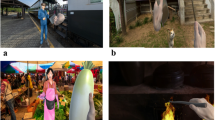Abstract
Virtual Technology (VT) plays a vital role in many areas. It is a promising tool in healthcare and offers opportunities and solutions for early detection of dementia. Dementia is associated with loss of brain function from the process of ageing. This serious illness needs early diagnosis if medical treatment and healthcare services are to be deployed in time. We developed a new prototype called Virtual Reality for Early Detection of Dementia (VReDD), and have applied psychology theories in an attempt to make an early diagnosis of dementia. In this paper, we will focus on the usability of user satisfaction for young participants to see the complexity and effectiveness of the prototype as a first step prior to the implementation the experiment with elderly, those with a mild cognitive impairment and Alzheimer patients. These preliminary findings show that the prototype is reliable and suitable to be used with elderly people.
Access this chapter
Tax calculation will be finalised at checkout
Purchases are for personal use only
Preview
Unable to display preview. Download preview PDF.
Similar content being viewed by others
References
National Health Service, Dementia, http://www.nhs.uk/Conditions/Dementia/Pages/Introduction.aspx
Iaria, G., Bogod, N., Fox, C.J., Barton, J.J.: Developmental topographical disorientation: Case one. Neuropsychologia 47(1), 30–40 (2009)
Aguirre, G.K., D’Esposito, M.: Topographical disorientation: a synthesis and taxonomy. Brain 122(9), 1613–1628 (1999)
Passini, R., Rainville, C., Marchand, N., Joanette, Y.: Wayfinding in dementia of the Alzheimer type: Planning abilities. Journal of Clinical and Experimental Neuropsychology 17(6), 820–832 (1995)
Cherrier, M.M., Mendez, M., Perryman, K.: Route Learning performance in Alzheimer disease patients. Neuropsychiatry, Neuropsychology and Behavioral Neurology 14(3), 159–168 (2001)
Moline, J.: Virtual reality for health care: a survey. In: Riva, G. (ed.) Virtual Reality in Neuro-Psycho-Physiology, pp. 3–34. IOS Press, Amsterdam (1998)
Ellis, S.R.: What are virtual environments? IEEE Computer Graphics and Applications 14(1), 17–22 (1994)
Sherman, W.R., Craig, A.B.: Understanding virtual reality: Interface, applicationand design. Morgan Kaufmann, San Francisco (2003)
Bowman, D.A., North, C., Chen, J., Polys, N.F., Pyla, P.S., Yilmaz, U.: Information-rich virtual environments: theory, tools, and research agenda. In: VRST 2003 Proceedings of the ACM Symposium on Virtual Reality Software and Technology, Japan, pp. 81–90 (2003)
Riecke, B.E., Van Veen, H.A.H.C., Bulthoff, H.H.: Visual Homing is possible without Landmarks - A Path Integration Study in Virtual Reality. Presence: Teleoperators and Virtual Environments 11(5), 443–473 (2002)
Rizzo, A.A., Wiederhold, M., Buckwalter, J.G.: Basic issues in the use of virtual environments for mental health applications. In: Riva, G., Wiederhold, B.K., Molinari, E. (eds.) Virtual Environments in Clinical Psychology and Neuroscience: Methods and Techniques in Advanced Patient-Therapist Interaction, pp. 123–145. IOS Press, Amsterdam (1998)
Costa, R.M., Carvalho, L.A.V., Aragon, D.F.: AVIRC: A Virtual city for cognitive rehabilitation. In: International Conference on Disabilities, Virtual Reality, and Associated Technologies, Italy, pp. 299–304 (2000)
Werner, P., Rabinowitz, S., Klinger, E., Korczyn, A.S., Josman, N.: The use of the virtual action planning supermarket for the diagnosis of mild cognitive impairment. Dementia and Geriatric Cognitive Disorders 27, 301–309 (2009)
Tippett, W.J., Lee, J.H., Zakzanis, K.K., Black, S.E., Mraz, R., Graham, S.J.: Visually navigating a virtual world with real-world impairments: A study of visually and spatially guided performance in individuals with mild cognitive impairments. Journal of Clinical and Experimental Neuropsychology 31(4), 447–454 (2008)
Hix, D., Hartson, H.R.: Developing User Interfaces: Ensuring Usability through Product & Process. John Wiley and Sons, New York (1993)
Author information
Authors and Affiliations
Editor information
Editors and Affiliations
Rights and permissions
Copyright information
© 2011 Springer-Verlag Berlin Heidelberg
About this paper
Cite this paper
Wan Shamsuddin, S.N., Ugail, H., Lesk, V. (2011). Development and Usability Evaluation of Virtual Environment for Early Diagnosis of Dementia. In: Zaman, H.B., et al. Visual Informatics: Sustaining Research and Innovations. IVIC 2011. Lecture Notes in Computer Science, vol 7067. Springer, Berlin, Heidelberg. https://doi.org/10.1007/978-3-642-25200-6_2
Download citation
DOI: https://doi.org/10.1007/978-3-642-25200-6_2
Publisher Name: Springer, Berlin, Heidelberg
Print ISBN: 978-3-642-25199-3
Online ISBN: 978-3-642-25200-6
eBook Packages: Computer ScienceComputer Science (R0)




